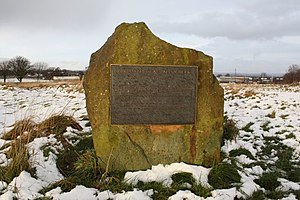User:GCAN57/sandbox
Battle of Adwalton Moor
[edit]| Battle of Adwalton Moor | |||||||
|---|---|---|---|---|---|---|---|
| Part of English Civil War | |||||||
| |||||||
| Belligerents | |||||||
| Royalists | Parliamentarians | ||||||
| Commanders and leaders | |||||||
| Earl of Newcastle | Lord Fairfax | ||||||
| Strength | |||||||
|
5,000 foot 5,000 horse |
3,000 foot 1,000 horse clubmen | ||||||
| Casualties and losses | |||||||
|
300 killed 200 wounded |
500 killed 500 wounded 1,500 captured | ||||||
The battle of Adwalton Moor was fought on 30 Jun 1643 near the village of Adwalton in West Yorkshire. In the battle, the Royalists led by the Earl of Newcastle inflicted a crushing defeat on the Parliamentarians commanded by Lord Fairfax.[1]
Background
[edit]During the first half of 1643, the Royalists under the Earl of Newcastle and the northern Parliamentarian army under Lord Fairfax fought for control of Yorkshire. They clashed on a number of occasions but neither side had gained a decisive advantage.[2]
On 22 June, Newcastle and the Roylists captured Howley Hall, the fortified mansion of Parliamentary supporter Lord Savile in Batley. Newcastle then advanced north with his army of 7,000 men which included an artillery tarin of two demi-cannons. His intent was to travel 12 kilometres to the northwest to attack the Parliamentarian garrison of Bradford. If the Royalists could be successful in the campaign, they would take control of West Yorkshire and its cloth manufacturing towns.[3]
When Lord Fairfax, the Parliamentary commander, was informed that the Royalist army was marching in the direction of Bradford, he made the decision to assemble his army of 7,500 men, leave the unfortified city of Bradford, and confront the Royalists in the open country. On 30 June, the two armies met on the Old Roman Road at Adwalton. In their respective histories of the battle, each side claimed that the other side was drawn up and positioned when they arrived. As so, it seems that neither side chose the location and the battle occurred where the two armies by chance happened to meet.[4]
The battle
[edit]Lord Fairfax and the Parliamentarians first encountered Royalist skirmishers at Wisket Hill. After driving the skirmishers back, the Parliamentarians moved to positions in enclosed fields and prepared to meet the Royalist army. Lord Fairfax commanded the centre formation as commander in chief. Sir Thomas Fairfax, Lord Fairfax's son, commanded the right wing and Major General Gifford commanded the left wing. At the outset of the battle, the Parliamentarians used their protected positions and numerical superiority of infantry to push the Royalists back. As the Parliamentarians continued to advance, they came to the edge of the open moor and forced the Royalists to retreat to the position of their artillery battery.[5]

After defending themselves for a while against cavalry attacks, the Parliamentarians moved into the open field and began to charge the Royalists, aiming to overrun their line and end the battle. In this charge the Parliamentarians were nearly successful. The Royalists seemed on the verge of conceding the battle when a contingent of Royalist pikemen drove back the Parliamentarian's left wing. The Royalist cavalry then swung around to the north and attacked the Parliamentarian's left flank. Gifford and his troopers collapsed and gave up the fight, retreating in a disorderly manner. The Royalist counterattack continued and Sir Thomas Fairfax on the right wing received his orders to retreat. Fairfax immediately retreated to the south as he discovered that the Royalists had cut the Parliamentarian right wing off from the main body of the Parliamentarian army.[6]
The battle was over. Broken and unorganized, the units of the Parliamentarian army returned to Bradford. It is estimated that 500 Parliamentarians were killed and 1,500 were captured as they tried to get back to Bradford. Royalist losses were estimated to be 200 killed and 300 wounded. [7]
| Royalists | Parliamentarians | |
|---|---|---|
| Commander | Earl of Newcastle | Lord Fairfax |
| Strength | 10,000 | 4,000 |
| Casualties | 500 | 2,000 |
Aftermath
[edit]With the Parliamentarians on the run, Newcastle advanced immediately. Overnight on 30 June, Newcastle brought his artillery to Bradford and on the morning of 1 July he began bombardment of the Parliamentarian garrison. The Parliamentarians attempted to break out, but were unsuccessful. Ultimately, the commanders left the town in small contingents of cavalry while the remainder of the army surrendered. Within a short period, the Parliamentarians surrendered Leeds and withdrew to Hull.[8]
The battle consolidated Royalist control of Yorkshire and has been deemed of low or medium term significance. However, historians have acknowledged that the impact of the battle, left the Parliamentarians with only Hull as a northern stronghold forcing them into a religious and political alliance with Scotland. This in turn, led to a Parliamentary victory at the Battle of Marston Moor a year later in 1644.[3] Historic England labelled the battle as second only in importance to Marston Moor.[9]
Notes
[edit]- ^ Johnson 2003, p. 21.
- ^ Cooke 2011, p. 22.
- ^ Binns 2004, p. 23.
- ^ Clark 2004, p. 24.
- ^ Johnson 2003, p. 25.
- ^ Binns 2004, p. 26.
- ^ Cooke 2011, p. 31.
- ^ Clark 2004, p. 31.
- ^ Binns 2004, p. 32.
References
[edit]- Binns, Jack (2004). Yorkshire in the Civil Wars. Pickering: Blackthorn Press. ISBN 0-9546300-2-5.
- Clark, David (2004). Marston Moor: English Civil War July 1644. Barnsley: Pen & Sword. ISBN 0-85052-985-9.
- Cooke, David (2011). The Civil War in Yorkshire:Fairfax versus Newcastle. Barnsley: Pen & Sword. ISBN 1-84415-076-3.
- Johnson, David (2003). Adwalton Moor 1642: The Battle that Changed a War. Pickering: Blackthorn Press. ISBN 0-9540535-8-3.
